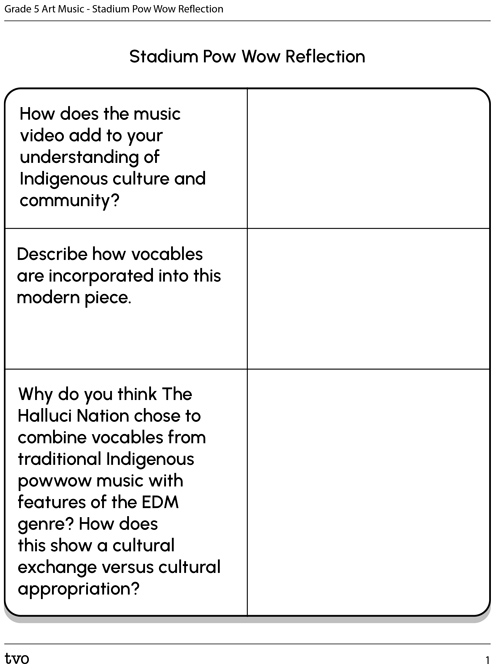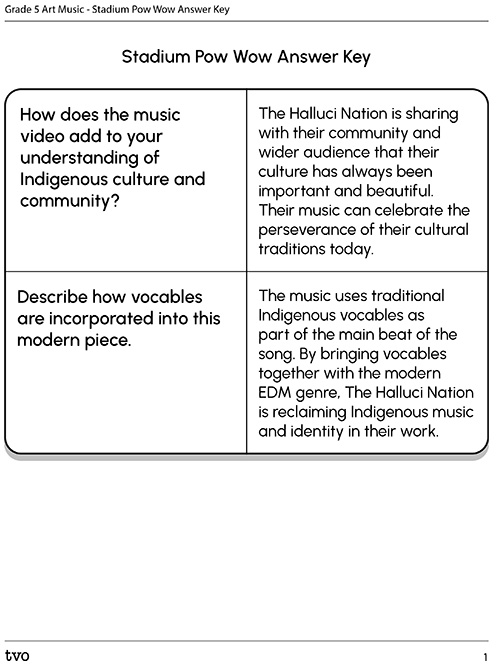Minds On
Today’s vocabulary
Press the following tabs to access today’s vocabulary.
Let’s get started!
Notice and wonder

Explore the following music clip entitled “Stadium Pow Wow” from the Indigenous musicians The Halluci Nation and Black Bear.
Consider and respond to the following questions:
- What did you notice about the song? What do you still wonder?
- Were there any new or unfamiliar sounds?
- What type or category of music do you think this belongs to?
Record your ideas using a method of your choice.
Action
Get ready, get set…
What is a genre?

Music is explored all around the world. There are many diverse styles of music, each with their own unique features. When we study styles of music, it is helpful to organize diverse styles into categories. These categories are known as genres.
Each genre uses specific music techniques, instruments and/or vocals. For example, in the jazz genre, complex harmony and improvisation are used. In rock and roll, the lead instrument has become the guitar.
What is harmony?
Two or more notes, or pitches sounding at the same time. Explore also chord; texture.
What is improvisation?
Music that is composed, played, or sung on the spot or spontaneously, without written music. Improvisation can be used to describe the music created or the activity of improvising.
There are many types of genres. Press the following tabs to explore just a few examples:
Have you experienced these genres or other genres of music? If so, describe what you noticed about that particular genre.
Record your ideas using a method of your choice. Share with a partner, if possible.
Vocables in Indigenous music
Let’s return to the audio clip you explored in the Minds On. The song “Stadium Pow Wow” was created by the Halluci Nation, who are a group of diverse First Nations musicians based in Ottawa, Ontario. The Halluci Nation frequently works with other musicians. In “Stadium Pow Wow”, they feature the drum group Black Bear from Manawan, Quebec.
What kind of features did you notice in the song “Stadium Pow Wow” by Halluci Nation?
Which genre might this type of music belong to?
Press ‘Features’ to check out some guiding ideas.
You may have noticed that “Stadium Pow Wow” had the following features:
- electronic sounds
- fast tempo
- heavy bass rhythms
“Stadium Pow Wow” is an example of the EDM genre. However, did you notice the use of vocals? The type of vocals that are included in the music clip are known as vocables.

Two teachers are discussing. The first teacher shares: “What are vocables?” The second teacher responds: “I have learned that vocables are sounds that are made up of different syllables such as “Hey-na”, or “Ya” or “Ho”. They help to communicate a song’s emotion. Sometimes vocables are more effective at communicating the feeling than words.” Vocables can be found across diverse types of Indigenous music, but this technique is historically rooted in the traditional singing featured at Indigenous cultural celebrations called powwows. Vocables are part of the traditional powwow music genre.
Diverse drumming practices
It is important to note that diverse Indigenous communities practice diverse teachings around drumming. Within the community, specific members participate in the big drum and the hand drum.
Check out the following video featuring young Ojibwe performer Joshua and his musical group the Redpath Singers as they perform traditional powwow music with a type of hand drum from Ojibwe culture.
What are some of the other features you notice in the previous example of the traditional powwow music genre?
Press ‘Answer’ to consider some possible features.
In this example of traditional powwow music, Joshua and the Redpath Singers sit in a circle facing each other. They create a steady rhythm with sticks and express themselves through vocables. There are times when all singers sing together, and there are times when one singer (Joshua) takes the lead by singing alone and the others join in after they complete their phrase.
How might vocables help to express emotion in this piece?
Press ‘Answer’ to check out a possible answer.
The rhythm stays the same throughout the piece, but the vocables change. When the singers all create vocables together, it feels strong and powerful. When Joshua starts singing on their own, and then the others join in, there is a feeling of support and strength.
Fusion
Now, let’s return to “Stadium Pow Wow” once more. It belongs to the EDM genre of music, but the artists also incorporated vocables, a feature of traditional powwow music. The technique of bringing two diverse styles of music from diverse genres together is called fusion.
What do you think is the purpose of creating fusion music?
Press ‘Answer’ to access a guiding idea.
Fusion combines two diverse genres to create something unique. Artists are able to learn from each genre and create new music for their audience.
What is cultural appropriation?

Throughout history, diverse cultures have inspired one another. However, issues arise when the concepts borrowed are not represented in a way that is respectful to the original culture.
Cultures exchange ideas and elements all the time. However, if there is a power imbalance between the culture being borrowed from and if that culture has not been treated fairly in the past, then the ‘borrowing’ or ‘inspiration’ crosses over from cultural exchange to cultural appropriation.
Appropriation is the act of taking something from someone else for one’s own use, often without the owner’s permission. Cultural appropriation happens when someone from one culture adopts elements of another culture without permission.
In First Nations, Métis, and Inuit cultures, music and dance are used for celebration, ceremony, and for entertainment. However, under the laws of the Indian Act, Indigenous peoples were banned from wearing their regalia, performing using traditional instruments in public, or gathering in groups to celebrate, mourn, heal or have fun together. Because of the complex history Indigenous peoples endured in Canada, many First Nations, Métis, and Inuit individuals did not learn these traditions from their parents, grandparents, or community members. This is why borrowing from Indigenous peoples and their cultures wouldn’t be a cultural exchange. It wouldn’t be fair to Indigenous peoples based on the oppression they have faced in Canada.
However, despite this history, Indigenous peoples continue to practice and reclaim their music and dances and express themselves and their cultures across Turtle Island. Many non-Indigenous Canadians also understand, by learning about this history, why it is so important for Indigenous peoples to have opportunities to experience their music, dances, and cultures today and also why Indigenous cultures including music and dance should not be appropriated.
Go!
Let’s return to following audio clip “Stadium Pow Wow” by the Halluci Nation featuring Black Bear. This music is a form of fusion, where Halluci Nation has brought traditional vocables together with EDM features.
Complete the Stadium Pow Wow Reflection chart in your notebook or using the following fillable and printable document. If you would like, you can use speech-to-text or audio recording tools to record your thoughts.

Press the Activity button to access the Stadium Pow Wow Reflection.
Activity (Open PDF in a new tab)Check out the following Stadium Pow Wow Answer Key to consider possible answers.
|
How does the audio clip add to your understanding of Indigenous culture and community? |
The Halluci Nation is sharing with their community and wider audience that their culture has always been important and beautiful. Their music can celebrate the perseverance of their cultural traditions today. |
|
Describe how vocables are incorporated into this modern piece. |
The music uses traditional Indigenous vocables as part of the main beat of the song. By bringing vocables together with the modern EDM genre, The Halluci Nation is reclaiming Indigenous music and identity in their work. |
|
Why do you think The Halluci Nation chose to combine vocables from traditional Indigenous Powwow music with features of the EDM genre? How does this show a cultural exchange versus cultural appropriation? |
The Halluci Nation is using fusion to bring together their two strengths of traditional Powwow vocables and the strong beat of EDM to create a powerful and contemporary kind of music. The Halluci Nation is made up of First Nations artists who work with other diverse musicians to create their music. They are celebrating their own cultural traditions in their music. Instead of appropriating a style from another culture, they work directly with other musicians to make something unique together based on their own diverse backgrounds. |

Press the Activity button to access the Stadium Pow Wow Answer Key.
Activity (Open PDF in a new tab)Consolidation
Putting it all together

Way to go! You have investigated many new ideas!
Use the following questions to reflect on your learning:
- How does the idea of “genre” help us organize music into groups?
- How can fusion music teach us about diverse cultures and traditions?
- What genres do you enjoy? Which would you like to explore more?
Record your responses using a method of your choice.
Reflection
As you read through these descriptions, which sentence best describes how you are feeling about your understanding of this learning activity? Press the button that is beside this sentence.
I feel…
Now, record your ideas using a voice recorder, speech-to-text, or writing tool.